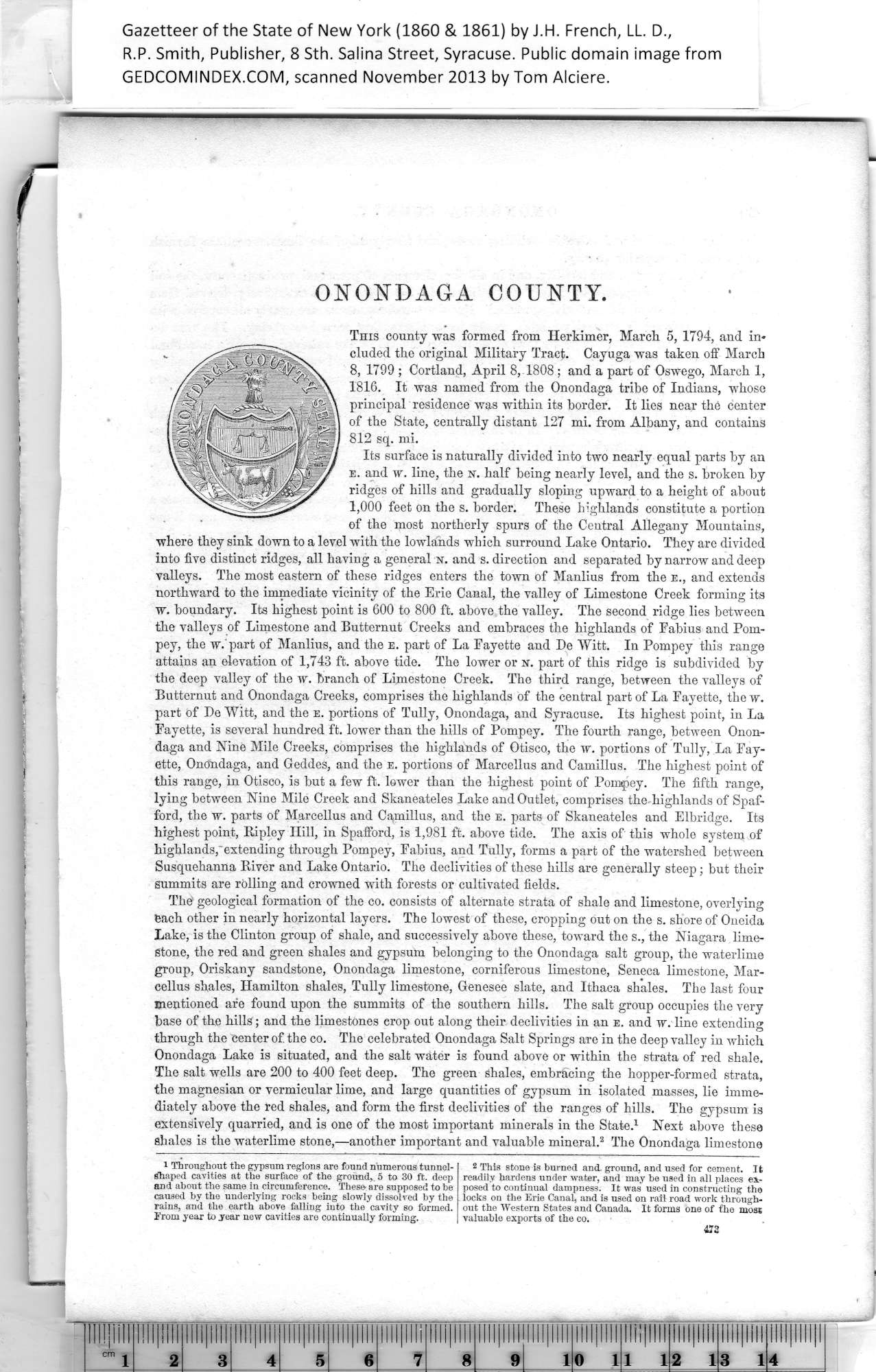|
ONONDAGA COUNTY.
This county was formed from Herkimer, March 5, 1794, and in*
eluded the original Military Tract. Cayuga was taken off March
8, 1799 ; Cortland, April 8, 1808 ; and a part of Oswego, March 1,
1816. It was named from the Onondaga tribe of Indians, whose
principal residence was within its border. It lies near the center
of the State, centrally distant 127 mi. from Albany, and contains
812 sq. mi.
Its surface is naturally divided into two nearly equal parts by an
E. and w. line, the n. half being nearly level, and the s. broken by
ridges of hills and gradually sloping upward to a height of about
1,000 feet on the s. border. These highlands constitute a portion
of the most northerly spurs of the Central Allegany Mountains,
where they sink down to a level with the lowlands which surround Lake Ontario. They are divided
into five distinct ridges, all having a general n. and s. direction and separated by narrow and deep
valleys. The most eastern of these ridges enters the town of Manlius from the e., and extends
northward to the immediate vicinity of the Erie Canal, the valley of Limestone Creek forming its
w. boundary. Its highest point is 600 to 800 ft. above the valley. The second ridge lies between
the valleys of Limestone and Butternut Creeks and embraces the highlands of Fabius and Pom¬
pey, the w. part of Manlius, and the e. part of La Fayette and De Witt. In Pompey this range
attains an elevation of 1,743 ft. above tide. The lower or N. part of this ridge is subdivided by
the deep valley of the w. branch of Limestone Creek. The third range, between the valleys of
Butternut and Onondaga Creeks, comprises the highlands of the central part of La Fayette, the w.
part of De Witt, and the e. portions of Tully, Onondaga, and Syracuse. Its highest point, in La
Fayette, is several hundred ft. lower than the hills of Pompey. The fourth range, between Onon¬
daga and Nine Mile Creeks, comprises the highlands of Otisco, the w. portions of Tully, La Fay¬
ette, Onondaga, and Geddes, and the e. portions of Marcellus and Camillus. The highest point of
this range, in Otisco, is but a few ft. lower than the highest point of Poirapey. The fifth range,
lying between Nine Mile Creek and Skaneateles Lake and Outlet, comprises the-highlands of Spaf¬
ford, the w. parts of Marcellus and Camillus, and the e. parts of Skaneateles and Elbridge. Its
highest point, Ripley Hill, in Spafford, is 1,981 ft. above tide. The axis of this whole system of
highlands,'extending through Pompey, Fabius, and Tully, forms a part of the watershed between
Susquehanna River and Lake Ontario. The declivities of these hills are generally steep; but their
summits are rolling and crowned with forests or cultivated fields.
The' geological formation of the co. consists of alternate strata of shale and limestone, overlying
feach other in nearly horizontal layers. The lowest of these, cropping out on the s. shore of Oneida
Lake, is the Clinton group of shale, and successively above these, toward the s., the Niagara lime¬
stone, the red and green shales and gypsum belonging to the Onondaga salt group, the waterlime
group, Oriskany sandstone, Onondaga limestone, corniferous limestone, Seneca limestone, Mar¬
cellus shales, Hamilton shales, Tully limestone, Genesee slate, and Ithaca shales. The last four
mentioned are found upon the summits of the southern hills. The salt group occupies the very
base of the hills; and the limestones crop out along their declivities in an e. and w. line extending
through the center of. the co. The celebrated Onondaga Salt Springs are in the deep valley in which
Onondaga Lake is situated, and the salt water is found above or within the strata of red shale.
The salt wells are 200 to 400 feet deep. The green shales, embracing the hopper-formed strata,
the magnesian or vermicular lime, and large quantities of gypsum in isolated masses, lie imme¬
diately above the red shales, and form the first declivities of the ranges of hills. The gypsum is
extensively quarried, and is one of the most important minerals in the State.1 Next above these
shales is the waterlime stone,—another important and valuable mineral.2 The Onondaga limestone
|
2 This stone is burned and. ground, and used for cement. It
readily hardens under water, and may be used in all places ex¬
posed to continual dampness. It was used in constructing the
locks on the Erie Canal, and is used on rail road work through¬
out the Western States and Canada. It forms one of t’he moss
valuable exports of the co. |
473
1
Throughout the gypsum regions are found numerous tunnel-
shaped cavities at the surface of the ground,. 5 to 30 ft. deep
and about the same in circumference. These are supposed to he
caused by the underlying rocks being slowly dissolved by the
rains, and the earth above falling into the cavity so formed.
From year to year new cavities are continually forming.
|
